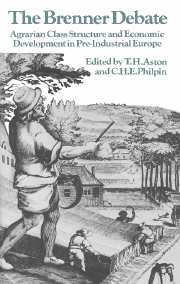Book contents
- Frontmatter
- Contents
- Preface
- Introduction
- 1 Agrarian Class Structure and Economic Development in Pre-Industrial Europe
- 2 Population and Class Relations in Feudal Society
- 3 Agrarian Class Structure and the Development of Capitalism: France and England Compared
- 4 Peasant Organization and Class Conflict in Eastern and Western Germany
- 5 A Reply to Robert Brenner
- 6 Against the Neo-Malthusian Orthodoxy
- 7 A Crisis of Feudalism
- 8 In Search of Agrarian Capitalism
- 9 Agrarian Class Structure and Economic Development in Pre-Industrial Bohemia
- 10 The Agrarian Roots of European Capitalism
- Index
- Past and Present Publications
1 - Agrarian Class Structure and Economic Development in Pre-Industrial Europe
Published online by Cambridge University Press: 27 October 2009
- Frontmatter
- Contents
- Preface
- Introduction
- 1 Agrarian Class Structure and Economic Development in Pre-Industrial Europe
- 2 Population and Class Relations in Feudal Society
- 3 Agrarian Class Structure and the Development of Capitalism: France and England Compared
- 4 Peasant Organization and Class Conflict in Eastern and Western Germany
- 5 A Reply to Robert Brenner
- 6 Against the Neo-Malthusian Orthodoxy
- 7 A Crisis of Feudalism
- 8 In Search of Agrarian Capitalism
- 9 Agrarian Class Structure and Economic Development in Pre-Industrial Bohemia
- 10 The Agrarian Roots of European Capitalism
- Index
- Past and Present Publications
Summary
General interpretations of the processes of long-term economic change in late medieval and early modern Europe have continued to be constructed almost exclusively in terms of what might loosely be called “objective” economic forces – in particular, demographic fluctuations and the growth of trade and markets. A variety of models have been constructed centring on these forces. But whatever the exact nature of the model, and whether the pressure for change is seen to arise from urbanization and the growth of trade or an autonomous demographic development, a market supply/demand mechanism is usually assumed to provide the elementary theoretical underpinnings. So, the response of the agrarian economy to economic pressures, whatever their source, is more or less taken for granted, viewed as occurring more or less automatically, in a direction economically determined by the “laws of supply and demand”.
In the construction of these economic models, the question of class structure tends to be treated in a variety of ways. Typically, there is the statement that one is abstracting (for the moment) from the social or class structure for certain analytical purposes. The fact remains that in the actual process of explanation, that is in the application of the model to specific economic historical developments, class structure tends, almost inevitably, to creep back in. Sometimes, it is inserted, in an ad hoc way, to comprehend a historical trend which the model cannot cover. More often, however, consciously or unconsciously, class structure is simply integrated within the model itself, and seen as essentially shaped by, or changeable in terms of, the objective economic forces around which the model has been constructed in the first place.
- Type
- Chapter
- Information
- The Brenner DebateAgrarian Class Structure and Economic Development in Pre-industrial Europe, pp. 10 - 63Publisher: Cambridge University PressPrint publication year: 1985
- 126
- Cited by



